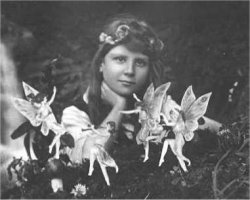- Sep 22, 2013
- 4,956
- 250
- 85
The fantasy history-based film "Photographing Fairies" (1997) presents themes of folklore such as possession, paganism, animism, hallucinogens, parapsychology, and fairies and was inspired by the famous Cottingley Fairies hoax.
The Cottingley Fairies incident involved two young girls in England who claimed to have photographs of seemingly tiny humanoid creatures moving around with flapping wings. These fairy creatures were dispelled as fakes, and the photographs dismissed as hoaxes, but the event stirred the curiosity of the likes of Sherlock Holmes detective story author Sir Arthur Conan Doyle.
Photography is a delicate but deliberate art. It involves the use of a device, a camera, to take still-like images from the real world and in real time and without physics or geometric manipulation. Photos are not impressions or images of objects like paintings but rather interpretations of the real orientation of real objects in the real world.
Photographs may be simple and straightforward for historical purposes (i.e., National Geographic Society) or they may be the work of artistic photographers (i.e., Ansel Adams) who intend to re-present real objects in terms of a psychic fascination with perception itself.
A picture is worth a thousand words, and these days, it seems almost everyone is walking around with a mobile phone with a handy-dandy built-in mini-camera inside it, making photography a 'pedestrian art.' Photo-sharing websites such as Flickr and Facebook cater to this modern artisanship colloquialization trend.
The real philosophical value of the Cottingley Fairies photos is that they invite scholars and artists alike to investigate the social forces that create curiosity about psychology.

Cottingley Fairies - Wikipedia the free encyclopedia

The Cottingley Fairies incident involved two young girls in England who claimed to have photographs of seemingly tiny humanoid creatures moving around with flapping wings. These fairy creatures were dispelled as fakes, and the photographs dismissed as hoaxes, but the event stirred the curiosity of the likes of Sherlock Holmes detective story author Sir Arthur Conan Doyle.
Photography is a delicate but deliberate art. It involves the use of a device, a camera, to take still-like images from the real world and in real time and without physics or geometric manipulation. Photos are not impressions or images of objects like paintings but rather interpretations of the real orientation of real objects in the real world.
Photographs may be simple and straightforward for historical purposes (i.e., National Geographic Society) or they may be the work of artistic photographers (i.e., Ansel Adams) who intend to re-present real objects in terms of a psychic fascination with perception itself.
A picture is worth a thousand words, and these days, it seems almost everyone is walking around with a mobile phone with a handy-dandy built-in mini-camera inside it, making photography a 'pedestrian art.' Photo-sharing websites such as Flickr and Facebook cater to this modern artisanship colloquialization trend.
The real philosophical value of the Cottingley Fairies photos is that they invite scholars and artists alike to investigate the social forces that create curiosity about psychology.

Cottingley Fairies - Wikipedia the free encyclopedia




